Overview
- Brief Narrative
- Gold cross pendant with remnants of offwhite enamel paint worn by 4 year old Charly Weingarten or his mother Margarethe when they lived in hiding under assumed identities as Catholics in Nice from 1943-1944. Charles was born in 1941 in Italian occupied Nice not long after his mother Margarethe's release from Gurs internment camp. She was a Jewish refugee from Nazi Germany who had resided primarily in France since the early 1930s. In 1943, the Germans, who had occupied northern France since May 1940, assumed control of much of southern France. Margarethe went into hiding with Charly under assumed identities as Catholics. They lived in poverty on the grounds of an estate and Charly suffered from chronic bronchitis and severe malnutrition. Nice was liberated by American troops in August 1944. After the war ended in May 1945, Charly was sent to a children's home in Switzerland to recuperate.
- Date
-
use:
1943-1944
- Geography
-
use:
Nice (France)
- Credit Line
- United States Holocaust Memorial Museum Collection, Gift of Charles Albert Weingarten
- Contributor
-
Subject:
Charles A. Weingarten
- Biography
-
Charles Albert Weingarten was born on January 13, 1941, in Nice, France, to Margarethe Weingarten, an actress, and Rudolf Gelb. Margarethe was born in 1904 in Leipzig, Germany, to a family of Belarusian and Polish furriers. She and her first husband, Karl Albert Foerst, left Germany for South America in the early 1930s, but Margarethe became ill and they moved to Paris, France. On November 7, 1938, Herschel Grynszpan, a Jewish youth walked into the German embassy in Paris and shot Ernst vom Rath, a German diplomat, who died two days. Nazi Party officials claimed it was the act of a worldwide Jewish conspiracy and used it as a pretext for Kristallnacht, the violent anti-Jewish pogrom in Germany on November 9-10. Margarethe and Karl, who were active in left-wing politics, were arrested by the French police and deported to Germany. Karl was shot in Buchenwald on January 20, 1939.
Margaret was able to return to Paris, accompanied by her mother, Glika Chaya Weingarten. In May 1940, Germany invaded France and Margarethe fled to Nice where she met Rudolf Gelb. Rudolf was a married Austrian Jew who had escaped from Dachau concentration camp in Germany and was in France as a foreign worker. In 1940, not long after Margarethe became pregnant, she was were sent to Gurs internment camp. Her mother was able to bribe someone in the camp and she was soon released. They returned to Nice and settled in the Italian occupied section where Charles was born. In 1943, the Germans occupied southern France. Margarethe hid with Charles in a basement. In July, she obtained false papers for them as Catholics and moved with Charles to the grounds of a villa owned by the Matteudi family. Rudolf escaped to Switzerland. Glika was given a hiding place in the convent of the Sisters of the Poor in Nice. Margarethe made canvas shoes to sell, but she made very little. They often had little to eat and Charles suffered from severe malnutrition and chronic bronchitis. Nice was liberated in late August 1944 and the war ended in May 1945. Charles was sent to recuperate in a Jewish children’s home in Switzerland. Rudolf survived the war in Switzerland and returned to Austria. Margarethe married Karl Ferdinand Delius, a photographer and journalist originally from Berlin. Margarethe, 65, passed away in 1969. Charles immigrated to the United States in the late 1960s, but returned to France in the 1990s.
Physical Details
- Classification
-
Jewelry
- Category
-
Necklaces
- Object Type
-
Pendants (Jewelry) (lcsh)
- Physical Description
- Gold colored, lacquered copper alloy metal pendant in the shape of a Latin cross with flared arms and a raised dot at the center. The arms have shiny raised centers with remnants of offwhite enamel paint and incised line borders. A suspension loop is inserted through a narrow slot at the top. The surface is scratched and the back discolored.
- Dimensions
- overall: Height: 1.375 inches (3.493 cm) | Width: 0.750 inches (1.905 cm) | Depth: 0.125 inches (0.318 cm)
- Materials
- overall : metal, enamel paint, lacquer
Rights & Restrictions
- Conditions on Access
- No restrictions on access
- Conditions on Use
- No restrictions on use
Keywords & Subjects
Administrative Notes
- Legal Status
- Permanent Collection
- Provenance
- The crucifix pendant was donated to the United States Holocaust Memorial Museum in 2002 by Charles Weingarten.
- Funding Note
- The cataloging of this artifact has been supported by a grant from the Conference on Jewish Material Claims Against Germany.
- Record last modified:
- 2023-09-01 09:00:08
- This page:
- https://collections.ushmm.org/search/catalog/irn518131
Download & Licensing
In-Person Research
- By Appointment
- Request 21 Days in Advance of Visit
- Plan a Research Visit
- Request to See This Object
Contact Us
Also in Charles A. Weingarten collection
The collection consists of artifacts, children's drawings, documents, and photographs relating to the experiences of Charles A. Weingarten and his family in prewar and wartime France where he lived as a hidden child, and after the war while he recuperated in Switzerland, and then returned to France. Charles Albert Weingarten is the son of Margarethe (Marguerite) Weingarten and Rudolph Gelb. He was born on Jan. 13, 1941, in Nice, France. In 1943 when the Germans invaded the area, Margarethe hid with Charles in the basement of a building in rue Verdi in Nice. In July 1943 Margarethe and Charles obtained false papers and moved to the grounds of a villa owned by the Matteudi family. They remained there through the end of World War II.
Date: 1940-1992
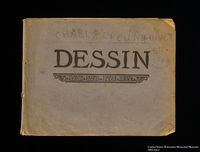
Sketchbook with make believe drawings by a former hidden child
Object
Sketchbook with 6 pages of imaginary drawing and sketches by Charles (Charly) Weingarten, 6, in 1947. Charles was born in 1941 in Italian occupied Nice, France, six months after his mother Margarethe was released from Gurs internment camp. She had fled Nazi Germany for France in the early 1930s. When Germany invaded in May 1940, she was jailed as an enemy alien, then released after the German victory. They lived openly until September 1943, when the Germans occupied southern France after Italy surrendered to the Allies. Margarethe got them false papers as Catholics, and they wore cross pendants (see records 2002.420.23-24.) But they went into hiding because of the danger of deportation. They lived in poverty, in a cellar on the grounds of an estate. Charles was ill with bronchitis and severe malnutrition. Nice was liberated by American troops in August 1944. After the war ended in May 1945, Charles was sent to a children's home in Switzerland to recuperate.
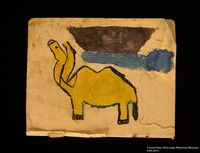
Sketchbook with 7 pages of drawings created in hiding by a young Jewish boy 2
Object
Sketchbook used by 6 year old Charly A. Weingarten in 1947. The drawings depict landscapes, animals, war scenes, and buildings. Charles was born in 1941 in Italian occupied Nice not long after his mother Margarethe's release from Gurs internment camp. She was a Jewish refugee from Nazi Germany who had resided primarily in France since the early 1930s. In 1943, the Germans, who had occupied northern France since May 1940, assumed control of much of southern France. Margarethe went into hiding with Charly under assumed identities as Catholics. They lived in poverty on the grounds of an estate and Charly suffered from chronic bronchitis and severe malnutrition. Nice was liberated by American troops in August 1944. After the war ended in May 1945, Charly was sent to a children's home in Switzerland to recuperate.
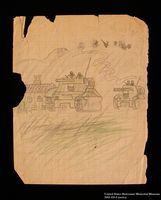
Double-sided drawing of tanks and a windmill by a hidden child
Object
Two-sided colored pencil drawing done by 4 year old Charly Weingarten circa 1944-1945 while living in hiding with his mother. The drawing depicts, on one side, tanks entering a village and, on the other side, a wind-mill and a man leading a horse. Charles was born in 1941 in Italian occupied Nice not long after his mother Margarethe's release from Gurs internment camp. She was a Jewish refugee from Nazi Germany who had resided primarily in France since the early 1930s. In 1943, the Germans, who had occupied northern France since May 1940, assumed control of much of southern France. Margarethe went into hiding with Charly under assumed identities as Catholics. They lived in poverty on the grounds of an estate and Charly suffered from chronic bronchitis and severe malnutrition. Nice was liberated by American troops in August 1944. After the war ended in May 1945, Charly was sent to a children's home in Switzerland to recuperate.
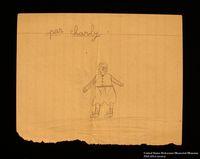
Double-sided drawing of a woman and Roman gladiators created by a hidden child
Object
Two-sided pencil drawing done by 4 year old Charly Weingarten circa 1944-1945 while living in hiding with his mother. The drawing depicts, on one side, a woman and, on the other side, Roman warrios with shields and swords. Charles was born in 1941 in Italian occupied Nice not long after his mother Margarethe's release from Gurs internment camp. She was a Jewish refugee from Nazi Germany who had resided primarily in France since the early 1930s. In 1943, the Germans, who had occupied northern France since May 1940, assumed control of much of southern France. Margarethe went into hiding with Charly under assumed identities as Catholics. They lived in poverty on the grounds of an estate and Charly suffered from chronic bronchitis and severe malnutrition. Nice was liberated by American troops in August 1944. After the war ended in May 1945, Charly was sent to a children's home in Switzerland to recuperate.
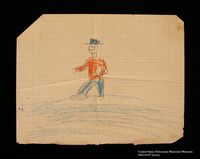
Double-sided drawing of a man and a French battleship created by a hidden child
Object
Two-sided colored pencil drawing done by 4 year old Charly Weingarten circa 1944-1945 while living in hiding with his mother. The drawing depicts, on one side, a man walking and, on the other side, a French battleship. Charles was born in 1941 in Italian occupied Nice not long after his mother Margarethe's release from Gurs internment camp. She was a Jewish refugee from Nazi Germany who had resided primarily in France since the early 1930s. In 1943, the Germans, who had occupied northern France since May 1940, assumed control of much of southern France. Margarethe went into hiding with Charly under assumed identities as Catholics. They lived in poverty on the grounds of an estate and Charly suffered from chronic bronchitis and severe malnutrition. Nice was liberated by American troops in August 1944. After the war ended in May 1945, Charly was sent to a children's home in Switzerland to recuperate.
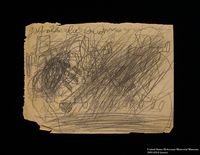
Double-sided drawing of battle scenes imagined by a hidden child
Object
Two-sided colored pencil drawing done by 4 year old Charly Weingarten circa 1944-1945 while living in hiding with his mother. The drawing depicts battle scenes. Charles was born in 1941 in Italian occupied Nice not long after his mother Margarethe's release from Gurs internment camp. She was a Jewish refugee from Nazi Germany who had resided primarily in France since the early 1930s. In 1943, the Germans, who had occupied northern France since May 1940, assumed control of much of southern France. Margarethe went into hiding with Charly under assumed identities as Catholics. They lived in poverty on the grounds of an estate and Charly suffered from chronic bronchitis and severe malnutrition. Nice was liberated by American troops in August 1944. After the war ended in May 1945, Charly was sent to a children's home in Switzerland to recuperate.
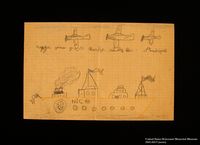
Double-sided drawing created by a hidden child
Object
Two-sided colored pencil drawing done by 4 year old Charly Weingarten circa 1944-1945 while living in hiding with his mother. Charles was born in 1941 in Italian occupied Nice not long after his mother Margarethe's release from Gurs internment camp. She was a Jewish refugee from Nazi Germany who had resided primarily in France since the early 1930s. In 1943, the Germans, who had occupied northern France since May 1940, assumed control of much of southern France. Margarethe went into hiding with Charly under assumed identities as Catholics. They lived in poverty on the grounds of an estate and Charly suffered from chronic bronchitis and severe malnutrition. Nice was liberated by American troops in August 1944. After the war ended in May 1945, Charly was sent to a children's home in Switzerland to recuperate.
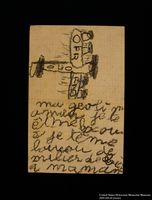
Double-sided drawing created by a hidden child
Object
Two-sided colored pencil drawing done by 4 year old Charly Weingarten circa 1944-1945 while living in hiding with his mother. Charles was born in 1941 in Italian occupied Nice not long after his mother Margarethe's release from Gurs internment camp. She was a Jewish refugee from Nazi Germany who had resided primarily in France since the early 1930s. In 1943, the Germans, who had occupied northern France since May 1940, assumed control of much of southern France. Margarethe went into hiding with Charly under assumed identities as Catholics. They lived in poverty on the grounds of an estate and Charly suffered from chronic bronchitis and severe malnutrition. Nice was liberated by American troops in August 1944. After the war ended in May 1945, Charly was sent to a children's home in Switzerland to recuperate.
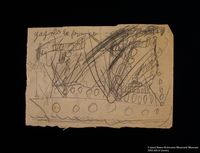
Double-sided drawing created by a hidden child
Object
Two-sided colored pencil drawing done by 4 year old Charly Weingarten circa 1944-1945 while living in hiding with his mother. Charles was born in 1941 in Italian occupied Nice not long after his mother Margarethe's release from Gurs internment camp. She was a Jewish refugee from Nazi Germany who had resided primarily in France since the early 1930s. In 1943, the Germans, who had occupied northern France since May 1940, assumed control of much of southern France. Margarethe went into hiding with Charly under assumed identities as Catholics. They lived in poverty on the grounds of an estate and Charly suffered from chronic bronchitis and severe malnutrition. Nice was liberated by American troops in August 1944. After the war ended in May 1945, Charly was sent to a children's home in Switzerland to recuperate.
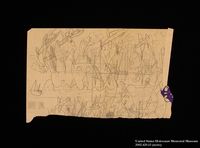
Double-sided drawing created by a hidden child
Object
Two-sided colored pencil drawing done by 4 year old Charly Weingarten circa 1944-1945 while living in hiding with his mother. Charles was born in 1941 in Italian occupied Nice not long after his mother Margarethe's release from Gurs internment camp. She was a Jewish refugee from Nazi Germany who had resided primarily in France since the early 1930s. In 1943, the Germans, who had occupied northern France since May 1940, assumed control of much of southern France. Margarethe went into hiding with Charly under assumed identities as Catholics. They lived in poverty on the grounds of an estate and Charly suffered from chronic bronchitis and severe malnutrition. Nice was liberated by American troops in August 1944. After the war ended in May 1945, Charly was sent to a children's home in Switzerland to recuperate.
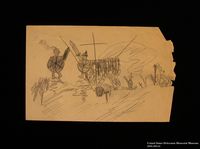
Double-sided drawing created by a hidden child
Object
Two-sided colored pencil drawing done by 4 year old Charly Weingarten circa 1944-1945 while living in hiding with his mother. Charles was born in 1941 in Italian occupied Nice not long after his mother Margarethe's release from Gurs internment camp. She was a Jewish refugee from Nazi Germany who had resided primarily in France since the early 1930s. In 1943, the Germans, who had occupied northern France since May 1940, assumed control of much of southern France. Margarethe went into hiding with Charly under assumed identities as Catholics. They lived in poverty on the grounds of an estate and Charly suffered from chronic bronchitis and severe malnutrition. Nice was liberated by American troops in August 1944. After the war ended in May 1945, Charly was sent to a children's home in Switzerland to recuperate.
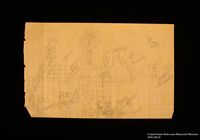
Double-sided drawing created by a hidden child
Object
Two-sided colored pencil drawing done by 4 year old Charly Weingarten circa 1944-1945 while living in hiding with his mother. Charles was born in 1941 in Italian occupied Nice not long after his mother Margarethe's release from Gurs internment camp. She was a Jewish refugee from Nazi Germany who had resided primarily in France since the early 1930s. In 1943, the Germans, who had occupied northern France since May 1940, assumed control of much of southern France. Margarethe went into hiding with Charly under assumed identities as Catholics. They lived in poverty on the grounds of an estate and Charly suffered from chronic bronchitis and severe malnutrition. Nice was liberated by American troops in August 1944. After the war ended in May 1945, Charly was sent to a children's home in Switzerland to recuperate.
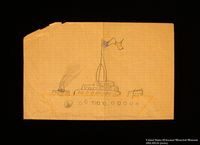
Double-sided drawing created by a hidden child
Object
Two-sided colored pencil drawing done by 4 year old Charly Weingarten circa 1944-1945 while living in hiding with his mother. Charles was born in 1941 in Italian occupied Nice not long after his mother Margarethe's release from Gurs internment camp. She was a Jewish refugee from Nazi Germany who had resided primarily in France since the early 1930s. In 1943, the Germans, who had occupied northern France since May 1940, assumed control of much of southern France. Margarethe went into hiding with Charly under assumed identities as Catholics. They lived in poverty on the grounds of an estate and Charly suffered from chronic bronchitis and severe malnutrition. Nice was liberated by American troops in August 1944. After the war ended in May 1945, Charly was sent to a children's home in Switzerland to recuperate.
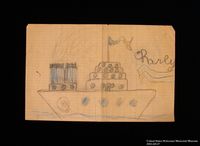
Colored pencil drawing created by a hidden child
Object
Colored pencil drawing done by 4 year old Charly Weingarten circa 1944-1945 while living in hiding with his mother. Charles was born in 1941 in Italian occupied Nice not long after his mother Margarethe's release from Gurs internment camp. She was a Jewish refugee from Nazi Germany who had resided primarily in France since the early 1930s. In 1943, the Germans, who had occupied northern France since May 1940, assumed control of much of southern France. Margarethe went into hiding with Charly under assumed identities as Catholics. They lived in poverty on the grounds of an estate and Charly suffered from chronic bronchitis and severe malnutrition. Nice was liberated by American troops in August 1944. After the war ended in May 1945, Charly was sent to a children's home in Switzerland to recuperate.
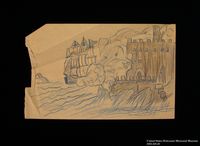
Colored pencil drawing created by a hidden child
Object
Colored pencil drawing done by 4 year old Charly Weingarten circa 1944-1945 while living in hiding with his mother. Charles was born in 1941 in Italian occupied Nice not long after his mother Margarethe's release from Gurs internment camp. She was a Jewish refugee from Nazi Germany who had resided primarily in France since the early 1930s. In 1943, the Germans, who had occupied northern France since May 1940, assumed control of much of southern France. Margarethe went into hiding with Charly under assumed identities as Catholics. They lived in poverty on the grounds of an estate and Charly suffered from chronic bronchitis and severe malnutrition. Nice was liberated by American troops in August 1944. After the war ended in May 1945, Charly was sent to a children's home in Switzerland to recuperate.
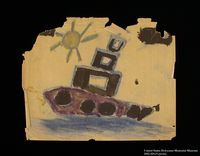
Double-sided painting created by a hidden child
Object
Two-sided painting done by 4 year old Charly Weingarten circa 1944-1945 while living in hiding with his mother. Charles was born in 1941 in Italian occupied Nice not long after his mother Margarethe's release from Gurs internment camp. She was a Jewish refugee from Nazi Germany who had resided primarily in France since the early 1930s. In 1943, the Germans, who had occupied northern France since May 1940, assumed control of much of southern France. Margarethe went into hiding with Charly under assumed identities as Catholics. They lived in poverty on the grounds of an estate and Charly suffered from chronic bronchitis and severe malnutrition. Nice was liberated by American troops in August 1944. After the war ended in May 1945, Charly was sent to a children's home in Switzerland to recuperate.
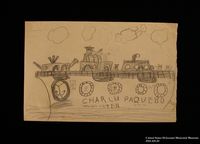
Pencil drawing created by a hidden child
Object
Pencil drawing done by 4 year old Charly Weingarten circa 1944-1945 while living in hiding with his mother. Charles was born in 1941 in Italian occupied Nice not long after his mother Margarethe's release from Gurs internment camp. She was a Jewish refugee from Nazi Germany who had resided primarily in France since the early 1930s. In 1943, the Germans, who had occupied northern France since May 1940, assumed control of much of southern France. Margarethe went into hiding with Charly under assumed identities as Catholics. They lived in poverty on the grounds of an estate and Charly suffered from chronic bronchitis and severe malnutrition. Nice was liberated by American troops in August 1944. After the war ended in May 1945, Charly was sent to a children's home in Switzerland to recuperate.
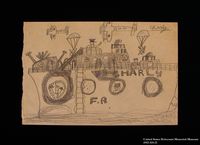
Pencil drawing created by a hidden child
Object
Pencil drawing done by 4 year old Charly Weingarten circa 1944-1945 while living in hiding with his mother. Charles was born in 1941 in Italian occupied Nice not long after his mother Margarethe's release from Gurs internment camp. She was a Jewish refugee from Nazi Germany who had resided primarily in France since the early 1930s. In 1943, the Germans, who had occupied northern France since May 1940, assumed control of much of southern France. Margarethe went into hiding with Charly under assumed identities as Catholics. They lived in poverty on the grounds of an estate and Charly suffered from chronic bronchitis and severe malnutrition. Nice was liberated by American troops in August 1944. After the war ended in May 1945, Charly was sent to a children's home in Switzerland to recuperate.
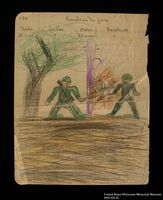
Colored pencil drawing created by a hidden child
Object
Colored pencil drawing done by 4 year old Charly Weingarten circa 1944-1945 while living in hiding with his mother. Charles was born in 1941 in Italian occupied Nice not long after his mother Margarethe's release from Gurs internment camp. She was a Jewish refugee from Nazi Germany who had resided primarily in France since the early 1930s. In 1943, the Germans, who had occupied northern France since May 1940, assumed control of much of southern France. Margarethe went into hiding with Charly under assumed identities as Catholics. They lived in poverty on the grounds of an estate and Charly suffered from chronic bronchitis and severe malnutrition. Nice was liberated by American troops in August 1944. After the war ended in May 1945, Charly was sent to a children's home in Switzerland to recuperate.
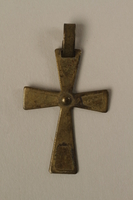
Gold cross pendant worn by a Jewish child or his mother in hiding as Catholics
Object
Gold cross pendant worn by 4 year old Charly Weingarten or his mother Margarethe when they lived in hiding under assumed identities as Catholics in Nice from 1943-1944. Charles was born in 1941 in Italian occupied Nice not long after his mother Margarethe's release from Gurs internment camp. She was a Jewish refugee from Nazi Germany who had resided primarily in France since the early 1930s. In 1943, the Germans, who had occupied northern France since May 1940, assumed control of much of southern France. Margarethe went into hiding with Charly under assumed identities as Catholics. They lived in poverty on the grounds of an estate and Charly suffered from chronic bronchitis and severe malnutrition. Nice was liberated by American troops in August 1944. After the war ended in May 1945, Charly was sent to a children's home in Switzerland to recuperate.
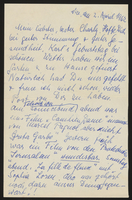
Charles Weingarten papers
Document
The Charles Weingarten papers include biographical materials, correspondence (some illustrated), photographs, printed materials, and restitution files documenting Weingarten’s extended family, hiding with his mother under a false identity in Nice, France, during World War II, their postwar lives, and Weingarten’s unsuccessful efforts to obtain compensation for Holocaust-era claims. The collection also includes records documenting the family of Weingarten’s stepfather, Karl Delius. Biographical materials include real and falsified identification papers for Charles and Margarethe Weingarten, Charles Weingarten’s medical records and membership cards, a certificate documenting Margarethe Weingarten’s liberation from Gurs in 1940, and records documenting her artistic career and her health. This series also includes electronic files containing extensive genealogical research and family trees compiled by Charles Weingarten. The correspondence series consists of extensive postwar correspondence from Margaret Weingarten and her mother and sisters, Paula and Charlotte, as well as postwar correspondence among Weingarten family members and friends. Additional correspondence documents aid that Margarethe and Charles Weingarten received after the war from individuals and relief organizations, Rudolf Gelb’s experiences as a volunteer foreign worker in France in 1940, and Charles’ experiences recuperating in children’s homes in Switzerland after the war and with Jewish youth groups in France in the 1960s. This series also includes illustrated holiday cards created by Charles Weingarten after the war for his mother. These cards include pencil, ink, and crayon drawings and watercolors by Weingarten, and some include photographs of Weingarten and his mother. Delius family papers consist of correspondence, photographs, and business records documenting the family of Charles Weingarten’s stepfather, Karl Ferdinand Delius, and their photography studio. Photographs include pictures of Weingarten, his mother, his biological father, his kindergarten class, and locations in Nice including the home where they hid during the last few years of the war. Three photograph albums include pictures of Charles Weingarten’s extended family in Germany, France, Switzerland, and Paraguay. Printed materials include a 1944 pamphlet describing Nazi persecution of Jews in Nice, reproductions of a letter written to Maréchal Pétain by a French woman describing her horror at the roundup of Jews in the Nice area for deportation, clippings about wartime and postwar France, the antifascist poetry pamphlet Deutschland muss leben…!,, a postwar publication about Jewish organizations in France, a booklet of cartoon drawings by Simon Haimovici, publications by survivor groups, and programs from postwar cultural events in France. Restitution files document Weingarten’s unsuccessful efforts in the 1990s and 2000s to obtain compensation for Holocaust-era claims related to issues such as bank accounts, mortgages, forced labor, and insurance policies. This series also includes wartime and postwar records documenting his mother’s and grandmother’s efforts to pursue restitution claims in the 1950s and 1960s.
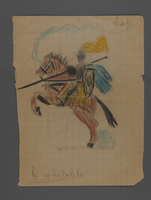
Watercolor drawing of a girl holding a basket
Object
Artwork created by Charles Weingarten after the war. Charles Albert Weingarten is the son of Margarethe (Marguerite) Weingarten and Rudolph Gelb. He was born on Jan. 13, 1941, in Nice, France. In 1943 when the Germans invaded the area, Margarethe hid with Charles in the basement of a building in rue Verdi in Nice. In July 1943 Margarethe and Charles obtained false papers and moved to the grounds of a villa owned by the Matteudi family. They remained there through the end of World War II.
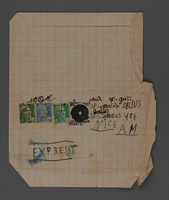
Handmade stamped letter
Object
Handmade letter created by Charles Weingarten after the war. Charles Albert Weingarten is the son of Margarethe (Marguerite) Weingarten and Rudolph Gelb. He was born on Jan. 13, 1941, in Nice, France. In 1943 when the Germans invaded the area, Margarethe hid with Charles in the basement of a building in rue Verdi in Nice. In July 1943 Margarethe and Charles obtained false papers and moved to the grounds of a villa owned by the Matteudi family. They remained there through the end of World War II.
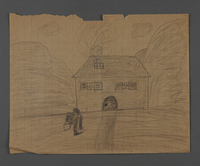
Double-sided pencil drawing of a train and a house
Object
Artwork created by Charles Weingarten after the war. Charles Albert Weingarten is the son of Margarethe (Marguerite) Weingarten and Rudolph Gelb. He was born on Jan. 13, 1941, in Nice, France. In 1943 when the Germans invaded the area, Margarethe hid with Charles in the basement of a building in rue Verdi in Nice. In July 1943 Margarethe and Charles obtained false papers and moved to the grounds of a villa owned by the Matteudi family. They remained there through the end of World War II.

Double-sided pencil drawing of a train and a house
Object
Artwork created by Charles Weingarten after the war. Charles Albert Weingarten is the son of Margarethe (Marguerite) Weingarten and Rudolph Gelb. He was born on Jan. 13, 1941, in Nice, France. In 1943 when the Germans invaded the area, Margarethe hid with Charles in the basement of a building in rue Verdi in Nice. In July 1943 Margarethe and Charles obtained false papers and moved to the grounds of a villa owned by the Matteudi family. They remained there through the end of World War II.
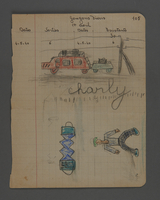
Drawing of a man, an accordion, and a car with trailer
Object
Artwork created by Charles Weingarten after the war. Charles Albert Weingarten is the son of Margarethe (Marguerite) Weingarten and Rudolph Gelb. He was born on Jan. 13, 1941, in Nice, France. In 1943 when the Germans invaded the area, Margarethe hid with Charles in the basement of a building in rue Verdi in Nice. In July 1943 Margarethe and Charles obtained false papers and moved to the grounds of a villa owned by the Matteudi family. They remained there through the end of World War II.

Double-sided drawing of a house and an airplane
Object
Artwork created by Charles Weingarten after the war. Charles Albert Weingarten is the son of Margarethe (Marguerite) Weingarten and Rudolph Gelb. He was born on Jan. 13, 1941, in Nice, France. In 1943 when the Germans invaded the area, Margarethe hid with Charles in the basement of a building in rue Verdi in Nice. In July 1943 Margarethe and Charles obtained false papers and moved to the grounds of a villa owned by the Matteudi family. They remained there through the end of World War II.
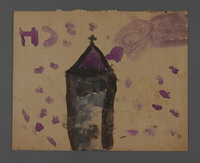
Watercolor drawing of a church
Object
Artwork created by Charles Weingarten after the war. Charles Albert Weingarten is the son of Margarethe (Marguerite) Weingarten and Rudolph Gelb. He was born on Jan. 13, 1941, in Nice, France. In 1943 when the Germans invaded the area, Margarethe hid with Charles in the basement of a building in rue Verdi in Nice. In July 1943 Margarethe and Charles obtained false papers and moved to the grounds of a villa owned by the Matteudi family. They remained there through the end of World War II.
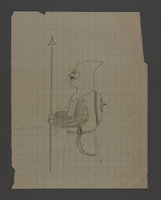
Pencil drawing depicting a knight
Object
Artwork created by Charles Weingarten after the war. Charles Albert Weingarten is the son of Margarethe (Marguerite) Weingarten and Rudolph Gelb. He was born on Jan. 13, 1941, in Nice, France. In 1943 when the Germans invaded the area, Margarethe hid with Charles in the basement of a building in rue Verdi in Nice. In July 1943 Margarethe and Charles obtained false papers and moved to the grounds of a villa owned by the Matteudi family. They remained there through the end of World War II.
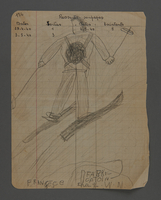
Double-sided drawing of a skier and a train
Object
Artwork created by Charles Weingarten after the war. Charles Albert Weingarten is the son of Margarethe (Marguerite) Weingarten and Rudolph Gelb. He was born on Jan. 13, 1941, in Nice, France. In 1943 when the Germans invaded the area, Margarethe hid with Charles in the basement of a building in rue Verdi in Nice. In July 1943 Margarethe and Charles obtained false papers and moved to the grounds of a villa owned by the Matteudi family. They remained there through the end of World War II.
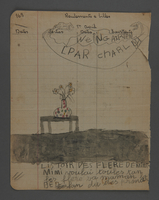
Double-sided drawing of a table with a vase of flowers and skiers
Object
Artwork created by Charles Weingarten after the war. Charles Albert Weingarten is the son of Margarethe (Marguerite) Weingarten and Rudolph Gelb. He was born on Jan. 13, 1941, in Nice, France. In 1943 when the Germans invaded the area, Margarethe hid with Charles in the basement of a building in rue Verdi in Nice. In July 1943 Margarethe and Charles obtained false papers and moved to the grounds of a villa owned by the Matteudi family. They remained there through the end of World War II.

Drawing depicting a car in front of a gate and a tree
Object
Artwork created by Charles Weingarten after the war. Charles Albert Weingarten is the son of Margarethe (Marguerite) Weingarten and Rudolph Gelb. He was born on Jan. 13, 1941, in Nice, France. In 1943 when the Germans invaded the area, Margarethe hid with Charles in the basement of a building in rue Verdi in Nice. In July 1943 Margarethe and Charles obtained false papers and moved to the grounds of a villa owned by the Matteudi family. They remained there through the end of World War II.
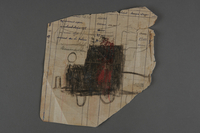
Double-sided crayon drawing depicting a train and a man with a hat
Object
Artwork created by Charles Weingarten after the war. Charles Albert Weingarten is the son of Margarethe (Marguerite) Weingarten and Rudolph Gelb. He was born on Jan. 13, 1941, in Nice, France. In 1943 when the Germans invaded the area, Margarethe hid with Charles in the basement of a building in rue Verdi in Nice. In July 1943 Margarethe and Charles obtained false papers and moved to the grounds of a villa owned by the Matteudi family. They remained there through the end of World War II.
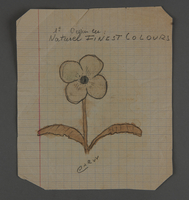
Watercolor and pencil drawing of a flower
Object
Artwork created by Charles Weingarten after the war. Charles Albert Weingarten is the son of Margarethe (Marguerite) Weingarten and Rudolph Gelb. He was born on Jan. 13, 1941, in Nice, France. In 1943 when the Germans invaded the area, Margarethe hid with Charles in the basement of a building in rue Verdi in Nice. In July 1943 Margarethe and Charles obtained false papers and moved to the grounds of a villa owned by the Matteudi family. They remained there through the end of World War II.
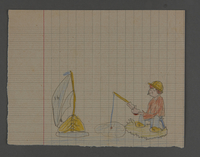
Drawing of a boy fishing
Object
Artwork created by Charles Weingarten after the war. Charles Albert Weingarten is the son of Margarethe (Marguerite) Weingarten and Rudolph Gelb. He was born on Jan. 13, 1941, in Nice, France. In 1943 when the Germans invaded the area, Margarethe hid with Charles in the basement of a building in rue Verdi in Nice. In July 1943 Margarethe and Charles obtained false papers and moved to the grounds of a villa owned by the Matteudi family. They remained there through the end of World War II.
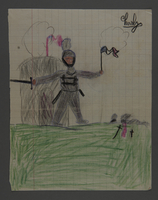
Drawing of a knight
Object
Artwork created by Charles Weingarten after the war. Charles Albert Weingarten is the son of Margarethe (Marguerite) Weingarten and Rudolph Gelb. He was born on Jan. 13, 1941, in Nice, France. In 1943 when the Germans invaded the area, Margarethe hid with Charles in the basement of a building in rue Verdi in Nice. In July 1943 Margarethe and Charles obtained false papers and moved to the grounds of a villa owned by the Matteudi family. They remained there through the end of World War II.

Drawing of a train
Object
Artwork created by Charles Weingarten after the war. Charles Albert Weingarten is the son of Margarethe (Marguerite) Weingarten and Rudolph Gelb. He was born on Jan. 13, 1941, in Nice, France. In 1943 when the Germans invaded the area, Margarethe hid with Charles in the basement of a building in rue Verdi in Nice. In July 1943 Margarethe and Charles obtained false papers and moved to the grounds of a villa owned by the Matteudi family. They remained there through the end of World War II.
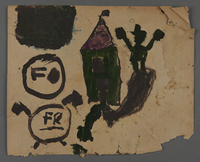
Double-sided watercolor drawings of buildings
Object
Artwork created by Charles Weingarten after the war. Charles Albert Weingarten is the son of Margarethe (Marguerite) Weingarten and Rudolph Gelb. He was born on Jan. 13, 1941, in Nice, France. In 1943 when the Germans invaded the area, Margarethe hid with Charles in the basement of a building in rue Verdi in Nice. In July 1943 Margarethe and Charles obtained false papers and moved to the grounds of a villa owned by the Matteudi family. They remained there through the end of World War II.

Drawing of various animal characters
Object
Artwork created by Charles Weingarten after the war. Charles Albert Weingarten is the son of Margarethe (Marguerite) Weingarten and Rudolph Gelb. He was born on Jan. 13, 1941, in Nice, France. In 1943 when the Germans invaded the area, Margarethe hid with Charles in the basement of a building in rue Verdi in Nice. In July 1943 Margarethe and Charles obtained false papers and moved to the grounds of a villa owned by the Matteudi family. They remained there through the end of World War II.
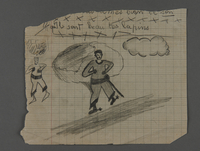
Pencil sketch
Object
Artwork created by Charles Weingarten after the war. Charles Albert Weingarten is the son of Margarethe (Marguerite) Weingarten and Rudolph Gelb. He was born on Jan. 13, 1941, in Nice, France. In 1943 when the Germans invaded the area, Margarethe hid with Charles in the basement of a building in rue Verdi in Nice. In July 1943 Margarethe and Charles obtained false papers and moved to the grounds of a villa owned by the Matteudi family. They remained there through the end of World War II.
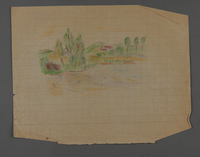
Colored pencil sketch of a landscape
Object
Artwork created by Charles Weingarten after the war. Charles Albert Weingarten is the son of Margarethe (Marguerite) Weingarten and Rudolph Gelb. He was born on Jan. 13, 1941, in Nice, France. In 1943 when the Germans invaded the area, Margarethe hid with Charles in the basement of a building in rue Verdi in Nice. In July 1943 Margarethe and Charles obtained false papers and moved to the grounds of a villa owned by the Matteudi family. They remained there through the end of World War II.

Pencil and crayon drawing depicting an Easter egg
Object
Artwork created by Charles Weingarten after the war. Charles Albert Weingarten is the son of Margarethe (Marguerite) Weingarten and Rudolph Gelb. He was born on Jan. 13, 1941, in Nice, France. In 1943 when the Germans invaded the area, Margarethe hid with Charles in the basement of a building in rue Verdi in Nice. In July 1943 Margarethe and Charles obtained false papers and moved to the grounds of a villa owned by the Matteudi family. They remained there through the end of World War II.
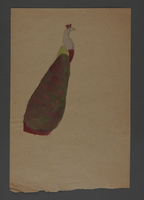
Watercolor drawing of a peacock
Object
Artwork created by Charles Weingarten after the war. Charles Albert Weingarten is the son of Margarethe (Marguerite) Weingarten and Rudolph Gelb. He was born on Jan. 13, 1941, in Nice, France. In 1943 when the Germans invaded the area, Margarethe hid with Charles in the basement of a building in rue Verdi in Nice. In July 1943 Margarethe and Charles obtained false papers and moved to the grounds of a villa owned by the Matteudi family. They remained there through the end of World War II.
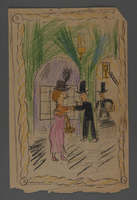
Crayon sketch of man and woman in fancy dress
Object
Artwork created by Charles Weingarten after the war. Charles Albert Weingarten is the son of Margarethe (Marguerite) Weingarten and Rudolph Gelb. He was born on Jan. 13, 1941, in Nice, France. In 1943 when the Germans invaded the area, Margarethe hid with Charles in the basement of a building in rue Verdi in Nice. In July 1943 Margarethe and Charles obtained false papers and moved to the grounds of a villa owned by the Matteudi family. They remained there through the end of World War II.
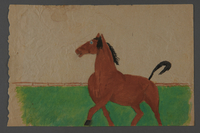
Watercolor drawing of a horse
Object
Artwork created by Charles Weingarten after the war. Charles Albert Weingarten is the son of Margarethe (Marguerite) Weingarten and Rudolph Gelb. He was born on Jan. 13, 1941, in Nice, France. In 1943 when the Germans invaded the area, Margarethe hid with Charles in the basement of a building in rue Verdi in Nice. In July 1943 Margarethe and Charles obtained false papers and moved to the grounds of a villa owned by the Matteudi family. They remained there through the end of World War II.
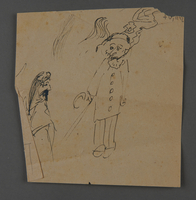
Ink sketch
Object
Artwork created by Charles Weingarten after the war. Charles Albert Weingarten is the son of Margarethe (Marguerite) Weingarten and Rudolph Gelb. He was born on Jan. 13, 1941, in Nice, France. In 1943 when the Germans invaded the area, Margarethe hid with Charles in the basement of a building in rue Verdi in Nice. In July 1943 Margarethe and Charles obtained false papers and moved to the grounds of a villa owned by the Matteudi family. They remained there through the end of World War II.
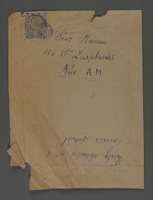
Letter and envelope created by Charles Weingarten
Object
Artwork created by Charles Weingarten after the war. Charles Albert Weingarten is the son of Margarethe (Marguerite) Weingarten and Rudolph Gelb. He was born on Jan. 13, 1941, in Nice, France. In 1943 when the Germans invaded the area, Margarethe hid with Charles in the basement of a building in rue Verdi in Nice. In July 1943 Margarethe and Charles obtained false papers and moved to the grounds of a villa owned by the Matteudi family. They remained there through the end of World War II.
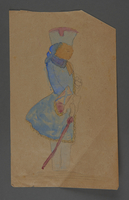
Watercolor drawing of a soldier
Object
Artwork created by Charles Weingarten after the war. Charles Albert Weingarten is the son of Margarethe (Marguerite) Weingarten and Rudolph Gelb. He was born on Jan. 13, 1941, in Nice, France. In 1943 when the Germans invaded the area, Margarethe hid with Charles in the basement of a building in rue Verdi in Nice. In July 1943 Margarethe and Charles obtained false papers and moved to the grounds of a villa owned by the Matteudi family. They remained there through the end of World War II.

Watercolor drawing of a horse
Object
Artwork created by Charles Weingarten after the war. Charles Albert Weingarten is the son of Margarethe (Marguerite) Weingarten and Rudolph Gelb. He was born on Jan. 13, 1941, in Nice, France. In 1943 when the Germans invaded the area, Margarethe hid with Charles in the basement of a building in rue Verdi in Nice. In July 1943 Margarethe and Charles obtained false papers and moved to the grounds of a villa owned by the Matteudi family. They remained there through the end of World War II.

Double-sided pencil sketch
Object
Artwork created by Charles Weingarten after the war. Charles Albert Weingarten is the son of Margarethe (Marguerite) Weingarten and Rudolph Gelb. He was born on Jan. 13, 1941, in Nice, France. In 1943 when the Germans invaded the area, Margarethe hid with Charles in the basement of a building in rue Verdi in Nice. In July 1943 Margarethe and Charles obtained false papers and moved to the grounds of a villa owned by the Matteudi family. They remained there through the end of World War II.

Pencil sketch depicting chickens
Object
Artwork created by Charles Weingarten after the war. Charles Albert Weingarten is the son of Margarethe (Marguerite) Weingarten and Rudolph Gelb. He was born on Jan. 13, 1941, in Nice, France. In 1943 when the Germans invaded the area, Margarethe hid with Charles in the basement of a building in rue Verdi in Nice. In July 1943 Margarethe and Charles obtained false papers and moved to the grounds of a villa owned by the Matteudi family. They remained there through the end of World War II.
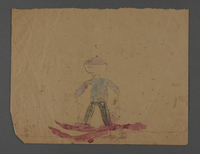
Pencil and watercolor double-sided sketch including depiction of a skier
Object
Artwork created by Charles Weingarten after the war. Charles Albert Weingarten is the son of Margarethe (Marguerite) Weingarten and Rudolph Gelb. He was born on Jan. 13, 1941, in Nice, France. In 1943 when the Germans invaded the area, Margarethe hid with Charles in the basement of a building in rue Verdi in Nice. In July 1943 Margarethe and Charles obtained false papers and moved to the grounds of a villa owned by the Matteudi family. They remained there through the end of World War II.
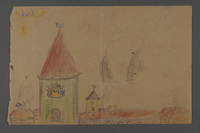
Drawing of buildings
Object
Artwork created by Charles Weingarten after the war. Charles Albert Weingarten is the son of Margarethe (Marguerite) Weingarten and Rudolph Gelb. He was born on Jan. 13, 1941, in Nice, France. In 1943 when the Germans invaded the area, Margarethe hid with Charles in the basement of a building in rue Verdi in Nice. In July 1943 Margarethe and Charles obtained false papers and moved to the grounds of a villa owned by the Matteudi family. They remained there through the end of World War II.
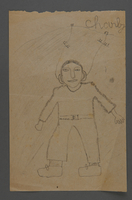
Pencil sketch
Object
Artwork created by Charles Weingarten after the war. Charles Albert Weingarten is the son of Margarethe (Marguerite) Weingarten and Rudolph Gelb. He was born on Jan. 13, 1941, in Nice, France. In 1943 when the Germans invaded the area, Margarethe hid with Charles in the basement of a building in rue Verdi in Nice. In July 1943 Margarethe and Charles obtained false papers and moved to the grounds of a villa owned by the Matteudi family. They remained there through the end of World War II.
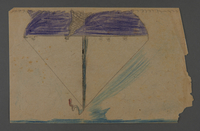
Double-sided sketch depicting a boat and a tree
Object
Artwork created by Charles Weingarten after the war. Charles Albert Weingarten is the son of Margarethe (Marguerite) Weingarten and Rudolph Gelb. He was born on Jan. 13, 1941, in Nice, France. In 1943 when the Germans invaded the area, Margarethe hid with Charles in the basement of a building in rue Verdi in Nice. In July 1943 Margarethe and Charles obtained false papers and moved to the grounds of a villa owned by the Matteudi family. They remained there through the end of World War II.
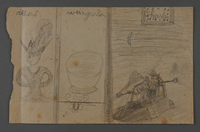
Double-sided pencil and crayon sketches
Object
Artwork created by Charles Weingarten after the war. Charles Albert Weingarten is the son of Margarethe (Marguerite) Weingarten and Rudolph Gelb. He was born on Jan. 13, 1941, in Nice, France. In 1943 when the Germans invaded the area, Margarethe hid with Charles in the basement of a building in rue Verdi in Nice. In July 1943 Margarethe and Charles obtained false papers and moved to the grounds of a villa owned by the Matteudi family. They remained there through the end of World War II.
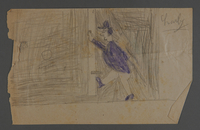
Pencil and crayon sketch
Object
Artwork created by Charles Weingarten after the war. Charles Albert Weingarten is the son of Margarethe (Marguerite) Weingarten and Rudolph Gelb. He was born on Jan. 13, 1941, in Nice, France. In 1943 when the Germans invaded the area, Margarethe hid with Charles in the basement of a building in rue Verdi in Nice. In July 1943 Margarethe and Charles obtained false papers and moved to the grounds of a villa owned by the Matteudi family. They remained there through the end of World War II.
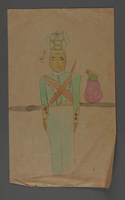
Watercolor drawing of a soldier
Object
Artwork created by Charles Weingarten after the war. Charles Albert Weingarten is the son of Margarethe (Marguerite) Weingarten and Rudolph Gelb. He was born on Jan. 13, 1941, in Nice, France. In 1943 when the Germans invaded the area, Margarethe hid with Charles in the basement of a building in rue Verdi in Nice. In July 1943 Margarethe and Charles obtained false papers and moved to the grounds of a villa owned by the Matteudi family. They remained there through the end of World War II.

Pencil sketch
Object
Artwork created by Charles Weingarten after the war. Charles Albert Weingarten is the son of Margarethe (Marguerite) Weingarten and Rudolph Gelb. He was born on Jan. 13, 1941, in Nice, France. In 1943 when the Germans invaded the area, Margarethe hid with Charles in the basement of a building in rue Verdi in Nice. In July 1943 Margarethe and Charles obtained false papers and moved to the grounds of a villa owned by the Matteudi family. They remained there through the end of World War II.
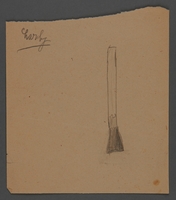
Pencil sketch
Object
Artwork created by Charles Weingarten after the war. Charles Albert Weingarten is the son of Margarethe (Marguerite) Weingarten and Rudolph Gelb. He was born on Jan. 13, 1941, in Nice, France. In 1943 when the Germans invaded the area, Margarethe hid with Charles in the basement of a building in rue Verdi in Nice. In July 1943 Margarethe and Charles obtained false papers and moved to the grounds of a villa owned by the Matteudi family. They remained there through the end of World War II.

Pencil sketch
Object
Artwork created by Charles Weingarten after the war. Charles Albert Weingarten is the son of Margarethe (Marguerite) Weingarten and Rudolph Gelb. He was born on Jan. 13, 1941, in Nice, France. In 1943 when the Germans invaded the area, Margarethe hid with Charles in the basement of a building in rue Verdi in Nice. In July 1943 Margarethe and Charles obtained false papers and moved to the grounds of a villa owned by the Matteudi family. They remained there through the end of World War II.
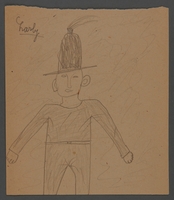
Pencil sketch
Object
Artwork created by Charles Weingarten after the war. Charles Albert Weingarten is the son of Margarethe (Marguerite) Weingarten and Rudolph Gelb. He was born on Jan. 13, 1941, in Nice, France. In 1943 when the Germans invaded the area, Margarethe hid with Charles in the basement of a building in rue Verdi in Nice. In July 1943 Margarethe and Charles obtained false papers and moved to the grounds of a villa owned by the Matteudi family. They remained there through the end of World War II.
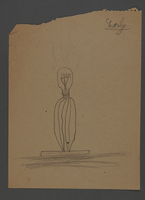
Pencil sketch
Object
Artwork created by Charles Weingarten after the war. Charles Albert Weingarten is the son of Margarethe (Marguerite) Weingarten and Rudolph Gelb. He was born on Jan. 13, 1941, in Nice, France. In 1943 when the Germans invaded the area, Margarethe hid with Charles in the basement of a building in rue Verdi in Nice. In July 1943 Margarethe and Charles obtained false papers and moved to the grounds of a villa owned by the Matteudi family. They remained there through the end of World War II.
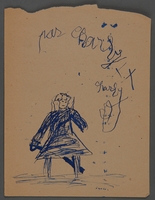
Ink sketch
Object
Artwork created by Charles Weingarten after the war. Charles Albert Weingarten is the son of Margarethe (Marguerite) Weingarten and Rudolph Gelb. He was born on Jan. 13, 1941, in Nice, France. In 1943 when the Germans invaded the area, Margarethe hid with Charles in the basement of a building in rue Verdi in Nice. In July 1943 Margarethe and Charles obtained false papers and moved to the grounds of a villa owned by the Matteudi family. They remained there through the end of World War II.

Pencil sketch
Object
Artwork created by Charles Weingarten after the war. Charles Albert Weingarten is the son of Margarethe (Marguerite) Weingarten and Rudolph Gelb. He was born on Jan. 13, 1941, in Nice, France. In 1943 when the Germans invaded the area, Margarethe hid with Charles in the basement of a building in rue Verdi in Nice. In July 1943 Margarethe and Charles obtained false papers and moved to the grounds of a villa owned by the Matteudi family. They remained there through the end of World War II.
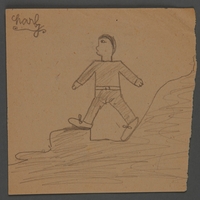
Pencil sketch
Object
Artwork created by Charles Weingarten after the war. Charles Albert Weingarten is the son of Margarethe (Marguerite) Weingarten and Rudolph Gelb. He was born on Jan. 13, 1941, in Nice, France. In 1943 when the Germans invaded the area, Margarethe hid with Charles in the basement of a building in rue Verdi in Nice. In July 1943 Margarethe and Charles obtained false papers and moved to the grounds of a villa owned by the Matteudi family. They remained there through the end of World War II.

Pencil sketch
Object
Artwork created by Charles Weingarten after the war. Charles Albert Weingarten is the son of Margarethe (Marguerite) Weingarten and Rudolph Gelb. He was born on Jan. 13, 1941, in Nice, France. In 1943 when the Germans invaded the area, Margarethe hid with Charles in the basement of a building in rue Verdi in Nice. In July 1943 Margarethe and Charles obtained false papers and moved to the grounds of a villa owned by the Matteudi family. They remained there through the end of World War II.
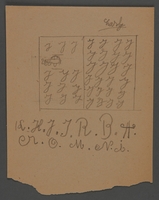
Pencil sketch
Object
Artwork created by Charles Weingarten after the war. Charles Albert Weingarten is the son of Margarethe (Marguerite) Weingarten and Rudolph Gelb. He was born on Jan. 13, 1941, in Nice, France. In 1943 when the Germans invaded the area, Margarethe hid with Charles in the basement of a building in rue Verdi in Nice. In July 1943 Margarethe and Charles obtained false papers and moved to the grounds of a villa owned by the Matteudi family. They remained there through the end of World War II.
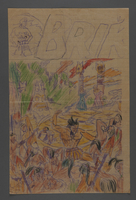
Colored pencil drawing
Object
Artwork created by Charles Weingarten after the war. Charles Albert Weingarten is the son of Margarethe (Marguerite) Weingarten and Rudolph Gelb. He was born on Jan. 13, 1941, in Nice, France. In 1943 when the Germans invaded the area, Margarethe hid with Charles in the basement of a building in rue Verdi in Nice. In July 1943 Margarethe and Charles obtained false papers and moved to the grounds of a villa owned by the Matteudi family. They remained there through the end of World War II.
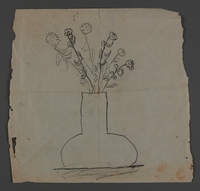
Pencil drawing with handwritten music score
Object
Artwork created by Charles Weingarten after the war. Charles Albert Weingarten is the son of Margarethe (Marguerite) Weingarten and Rudolph Gelb. He was born on Jan. 13, 1941, in Nice, France. In 1943 when the Germans invaded the area, Margarethe hid with Charles in the basement of a building in rue Verdi in Nice. In July 1943 Margarethe and Charles obtained false papers and moved to the grounds of a villa owned by the Matteudi family. They remained there through the end of World War II.
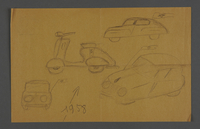
Pencil sketch
Object
Artwork created by Charles Weingarten after the war. Charles Albert Weingarten is the son of Margarethe (Marguerite) Weingarten and Rudolph Gelb. He was born on Jan. 13, 1941, in Nice, France. In 1943 when the Germans invaded the area, Margarethe hid with Charles in the basement of a building in rue Verdi in Nice. In July 1943 Margarethe and Charles obtained false papers and moved to the grounds of a villa owned by the Matteudi family. They remained there through the end of World War II.
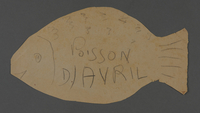
Cutout in the shape of a fish
Object
Artwork created by Charles Weingarten after the war. Charles Albert Weingarten is the son of Margarethe (Marguerite) Weingarten and Rudolph Gelb. He was born on Jan. 13, 1941, in Nice, France. In 1943 when the Germans invaded the area, Margarethe hid with Charles in the basement of a building in rue Verdi in Nice. In July 1943 Margarethe and Charles obtained false papers and moved to the grounds of a villa owned by the Matteudi family. They remained there through the end of World War II.
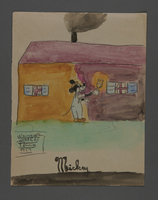
Watercolor depicting Mickey Mouse painting a house
Object
Artwork created by Charles Weingarten after the war. Charles Albert Weingarten is the son of Margarethe (Marguerite) Weingarten and Rudolph Gelb. He was born on Jan. 13, 1941, in Nice, France. In 1943 when the Germans invaded the area, Margarethe hid with Charles in the basement of a building in rue Verdi in Nice. In July 1943 Margarethe and Charles obtained false papers and moved to the grounds of a villa owned by the Matteudi family. They remained there through the end of World War II.

Drawing on cardboard of a man riding a horse
Object
Artwork created by Charles Weingarten after the war. Charles Albert Weingarten is the son of Margarethe (Marguerite) Weingarten and Rudolph Gelb. He was born on Jan. 13, 1941, in Nice, France. In 1943 when the Germans invaded the area, Margarethe hid with Charles in the basement of a building in rue Verdi in Nice. In July 1943 Margarethe and Charles obtained false papers and moved to the grounds of a villa owned by the Matteudi family. They remained there through the end of World War II.

Drawing on cardboard of a house
Object
Artwork created by Charles Weingarten after the war. Charles Albert Weingarten is the son of Margarethe (Marguerite) Weingarten and Rudolph Gelb. He was born on Jan. 13, 1941, in Nice, France. In 1943 when the Germans invaded the area, Margarethe hid with Charles in the basement of a building in rue Verdi in Nice. In July 1943 Margarethe and Charles obtained false papers and moved to the grounds of a villa owned by the Matteudi family. They remained there through the end of World War II.
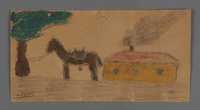
Drawing on cardboard of a house
Object
Artwork created by Charles Weingarten after the war. Charles Albert Weingarten is the son of Margarethe (Marguerite) Weingarten and Rudolph Gelb. He was born on Jan. 13, 1941, in Nice, France. In 1943 when the Germans invaded the area, Margarethe hid with Charles in the basement of a building in rue Verdi in Nice. In July 1943 Margarethe and Charles obtained false papers and moved to the grounds of a villa owned by the Matteudi family. They remained there through the end of World War II.
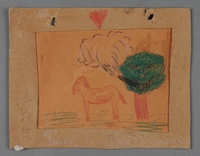
Colored pencil drawing
Object
Artwork created by Charles Weingarten after the war. Charles Albert Weingarten is the son of Margarethe (Marguerite) Weingarten and Rudolph Gelb. He was born on Jan. 13, 1941, in Nice, France. In 1943 when the Germans invaded the area, Margarethe hid with Charles in the basement of a building in rue Verdi in Nice. In July 1943 Margarethe and Charles obtained false papers and moved to the grounds of a villa owned by the Matteudi family. They remained there through the end of World War II.

Drawing of a flower
Object
Artwork created by Charles Weingarten after the war. Charles Albert Weingarten is the son of Margarethe (Marguerite) Weingarten and Rudolph Gelb. He was born on Jan. 13, 1941, in Nice, France. In 1943 when the Germans invaded the area, Margarethe hid with Charles in the basement of a building in rue Verdi in Nice. In July 1943 Margarethe and Charles obtained false papers and moved to the grounds of a villa owned by the Matteudi family. They remained there through the end of World War II.
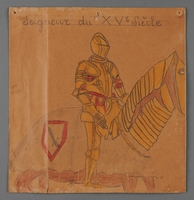
Drawing of a knight
Object
Artwork created by Charles Weingarten after the war. Charles Albert Weingarten is the son of Margarethe (Marguerite) Weingarten and Rudolph Gelb. He was born on Jan. 13, 1941, in Nice, France. In 1943 when the Germans invaded the area, Margarethe hid with Charles in the basement of a building in rue Verdi in Nice. In July 1943 Margarethe and Charles obtained false papers and moved to the grounds of a villa owned by the Matteudi family. They remained there through the end of World War II.
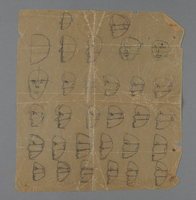
Pencil sketches
Object
Artwork created by Charles Weingarten after the war. Charles Albert Weingarten is the son of Margarethe (Marguerite) Weingarten and Rudolph Gelb. He was born on Jan. 13, 1941, in Nice, France. In 1943 when the Germans invaded the area, Margarethe hid with Charles in the basement of a building in rue Verdi in Nice. In July 1943 Margarethe and Charles obtained false papers and moved to the grounds of a villa owned by the Matteudi family. They remained there through the end of World War II.
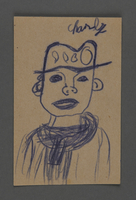
Ink drawing
Object
Artwork created by Charles Weingarten after the war. Charles Albert Weingarten is the son of Margarethe (Marguerite) Weingarten and Rudolph Gelb. He was born on Jan. 13, 1941, in Nice, France. In 1943 when the Germans invaded the area, Margarethe hid with Charles in the basement of a building in rue Verdi in Nice. In July 1943 Margarethe and Charles obtained false papers and moved to the grounds of a villa owned by the Matteudi family. They remained there through the end of World War II.
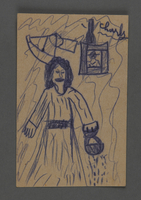
Ink drawing
Object
Artwork created by Charles Weingarten after the war. Charles Albert Weingarten is the son of Margarethe (Marguerite) Weingarten and Rudolph Gelb. He was born on Jan. 13, 1941, in Nice, France. In 1943 when the Germans invaded the area, Margarethe hid with Charles in the basement of a building in rue Verdi in Nice. In July 1943 Margarethe and Charles obtained false papers and moved to the grounds of a villa owned by the Matteudi family. They remained there through the end of World War II.

Ink drawing
Object
Artwork created by Charles Weingarten after the war. Charles Albert Weingarten is the son of Margarethe (Marguerite) Weingarten and Rudolph Gelb. He was born on Jan. 13, 1941, in Nice, France. In 1943 when the Germans invaded the area, Margarethe hid with Charles in the basement of a building in rue Verdi in Nice. In July 1943 Margarethe and Charles obtained false papers and moved to the grounds of a villa owned by the Matteudi family. They remained there through the end of World War II.
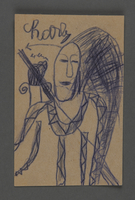
Ink drawing
Object
Artwork created by Charles Weingarten after the war. Charles Albert Weingarten is the son of Margarethe (Marguerite) Weingarten and Rudolph Gelb. He was born on Jan. 13, 1941, in Nice, France. In 1943 when the Germans invaded the area, Margarethe hid with Charles in the basement of a building in rue Verdi in Nice. In July 1943 Margarethe and Charles obtained false papers and moved to the grounds of a villa owned by the Matteudi family. They remained there through the end of World War II.
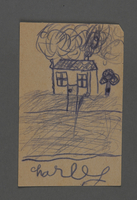
Ink drawing
Object
Artwork created by Charles Weingarten after the war. Charles Albert Weingarten is the son of Margarethe (Marguerite) Weingarten and Rudolph Gelb. He was born on Jan. 13, 1941, in Nice, France. In 1943 when the Germans invaded the area, Margarethe hid with Charles in the basement of a building in rue Verdi in Nice. In July 1943 Margarethe and Charles obtained false papers and moved to the grounds of a villa owned by the Matteudi family. They remained there through the end of World War II.
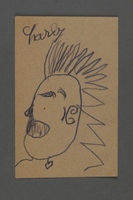
Ink drawing
Object
Artwork created by Charles Weingarten after the war. Charles Albert Weingarten is the son of Margarethe (Marguerite) Weingarten and Rudolph Gelb. He was born on Jan. 13, 1941, in Nice, France. In 1943 when the Germans invaded the area, Margarethe hid with Charles in the basement of a building in rue Verdi in Nice. In July 1943 Margarethe and Charles obtained false papers and moved to the grounds of a villa owned by the Matteudi family. They remained there through the end of World War II.
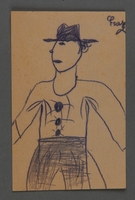
Ink drawing
Object
Artwork created by Charles Weingarten after the war. Charles Albert Weingarten is the son of Margarethe (Marguerite) Weingarten and Rudolph Gelb. He was born on Jan. 13, 1941, in Nice, France. In 1943 when the Germans invaded the area, Margarethe hid with Charles in the basement of a building in rue Verdi in Nice. In July 1943 Margarethe and Charles obtained false papers and moved to the grounds of a villa owned by the Matteudi family. They remained there through the end of World War II.
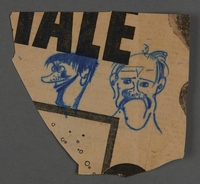
Ink sketches
Object
Artwork created by Charles Weingarten after the war. Charles Albert Weingarten is the son of Margarethe (Marguerite) Weingarten and Rudolph Gelb. He was born on Jan. 13, 1941, in Nice, France. In 1943 when the Germans invaded the area, Margarethe hid with Charles in the basement of a building in rue Verdi in Nice. In July 1943 Margarethe and Charles obtained false papers and moved to the grounds of a villa owned by the Matteudi family. They remained there through the end of World War II.
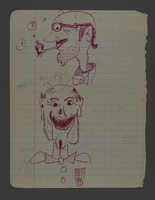
Ink sketches
Object
Artwork created by Charles Weingarten after the war. Charles Albert Weingarten is the son of Margarethe (Marguerite) Weingarten and Rudolph Gelb. He was born on Jan. 13, 1941, in Nice, France. In 1943 when the Germans invaded the area, Margarethe hid with Charles in the basement of a building in rue Verdi in Nice. In July 1943 Margarethe and Charles obtained false papers and moved to the grounds of a villa owned by the Matteudi family. They remained there through the end of World War II.
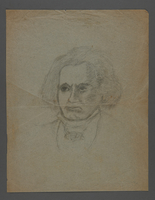
Pencil sketch
Object
Artwork created by Charles Weingarten after the war. Charles Albert Weingarten is the son of Margarethe (Marguerite) Weingarten and Rudolph Gelb. He was born on Jan. 13, 1941, in Nice, France. In 1943 when the Germans invaded the area, Margarethe hid with Charles in the basement of a building in rue Verdi in Nice. In July 1943 Margarethe and Charles obtained false papers and moved to the grounds of a villa owned by the Matteudi family. They remained there through the end of World War II.

Drawings of a Greek ship and a 17th century frigate
Object
Artwork created by Charles Weingarten after the war. Charles Albert Weingarten is the son of Margarethe (Marguerite) Weingarten and Rudolph Gelb. He was born on Jan. 13, 1941, in Nice, France. In 1943 when the Germans invaded the area, Margarethe hid with Charles in the basement of a building in rue Verdi in Nice. In July 1943 Margarethe and Charles obtained false papers and moved to the grounds of a villa owned by the Matteudi family. They remained there through the end of World War II.

Drawing of a ship
Object
Artwork created by Charles Weingarten after the war. Charles Albert Weingarten is the son of Margarethe (Marguerite) Weingarten and Rudolph Gelb. He was born on Jan. 13, 1941, in Nice, France. In 1943 when the Germans invaded the area, Margarethe hid with Charles in the basement of a building in rue Verdi in Nice. In July 1943 Margarethe and Charles obtained false papers and moved to the grounds of a villa owned by the Matteudi family. They remained there through the end of World War II.
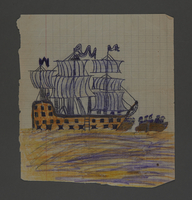
Drawing of a ship
Object
Artwork created by Charles Weingarten after the war. Charles Albert Weingarten is the son of Margarethe (Marguerite) Weingarten and Rudolph Gelb. He was born on Jan. 13, 1941, in Nice, France. In 1943 when the Germans invaded the area, Margarethe hid with Charles in the basement of a building in rue Verdi in Nice. In July 1943 Margarethe and Charles obtained false papers and moved to the grounds of a villa owned by the Matteudi family. They remained there through the end of World War II.
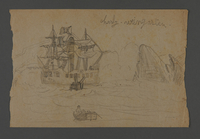
Drawing of a ship
Object
Artwork created by Charles Weingarten after the war. Charles Albert Weingarten is the son of Margarethe (Marguerite) Weingarten and Rudolph Gelb. He was born on Jan. 13, 1941, in Nice, France. In 1943 when the Germans invaded the area, Margarethe hid with Charles in the basement of a building in rue Verdi in Nice. In July 1943 Margarethe and Charles obtained false papers and moved to the grounds of a villa owned by the Matteudi family. They remained there through the end of World War II.
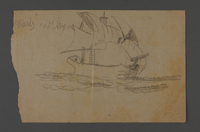
Drawing of a ship
Object
Artwork created by Charles Weingarten after the war. Charles Albert Weingarten is the son of Margarethe (Marguerite) Weingarten and Rudolph Gelb. He was born on Jan. 13, 1941, in Nice, France. In 1943 when the Germans invaded the area, Margarethe hid with Charles in the basement of a building in rue Verdi in Nice. In July 1943 Margarethe and Charles obtained false papers and moved to the grounds of a villa owned by the Matteudi family. They remained there through the end of World War II.

Drawing of a ship
Object
Artwork created by Charles Weingarten after the war. Charles Albert Weingarten is the son of Margarethe (Marguerite) Weingarten and Rudolph Gelb. He was born on Jan. 13, 1941, in Nice, France. In 1943 when the Germans invaded the area, Margarethe hid with Charles in the basement of a building in rue Verdi in Nice. In July 1943 Margarethe and Charles obtained false papers and moved to the grounds of a villa owned by the Matteudi family. They remained there through the end of World War II.
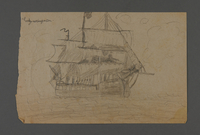
Drawing of a ship
Object
Artwork created by Charles Weingarten after the war. Charles Albert Weingarten is the son of Margarethe (Marguerite) Weingarten and Rudolph Gelb. He was born on Jan. 13, 1941, in Nice, France. In 1943 when the Germans invaded the area, Margarethe hid with Charles in the basement of a building in rue Verdi in Nice. In July 1943 Margarethe and Charles obtained false papers and moved to the grounds of a villa owned by the Matteudi family. They remained there through the end of World War II.
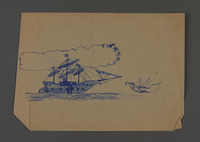
Drawing of a ship
Object
Artwork created by Charles Weingarten after the war. Charles Albert Weingarten is the son of Margarethe (Marguerite) Weingarten and Rudolph Gelb. He was born on Jan. 13, 1941, in Nice, France. In 1943 when the Germans invaded the area, Margarethe hid with Charles in the basement of a building in rue Verdi in Nice. In July 1943 Margarethe and Charles obtained false papers and moved to the grounds of a villa owned by the Matteudi family. They remained there through the end of World War II.
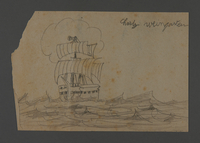
Drawing of a ship
Object
Artwork created by Charles Weingarten after the war. Charles Albert Weingarten is the son of Margarethe (Marguerite) Weingarten and Rudolph Gelb. He was born on Jan. 13, 1941, in Nice, France. In 1943 when the Germans invaded the area, Margarethe hid with Charles in the basement of a building in rue Verdi in Nice. In July 1943 Margarethe and Charles obtained false papers and moved to the grounds of a villa owned by the Matteudi family. They remained there through the end of World War II.
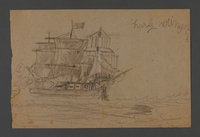
Drawing of a ship
Object
Artwork created by Charles Weingarten after the war. Charles Albert Weingarten is the son of Margarethe (Marguerite) Weingarten and Rudolph Gelb. He was born on Jan. 13, 1941, in Nice, France. In 1943 when the Germans invaded the area, Margarethe hid with Charles in the basement of a building in rue Verdi in Nice. In July 1943 Margarethe and Charles obtained false papers and moved to the grounds of a villa owned by the Matteudi family. They remained there through the end of World War II.

Drawing of a ship
Object
Artwork created by Charles Weingarten after the war. Charles Albert Weingarten is the son of Margarethe (Marguerite) Weingarten and Rudolph Gelb. He was born on Jan. 13, 1941, in Nice, France. In 1943 when the Germans invaded the area, Margarethe hid with Charles in the basement of a building in rue Verdi in Nice. In July 1943 Margarethe and Charles obtained false papers and moved to the grounds of a villa owned by the Matteudi family. They remained there through the end of World War II.

Drawing of a ship
Object
Artwork created by Charles Weingarten after the war. Charles Albert Weingarten is the son of Margarethe (Marguerite) Weingarten and Rudolph Gelb. He was born on Jan. 13, 1941, in Nice, France. In 1943 when the Germans invaded the area, Margarethe hid with Charles in the basement of a building in rue Verdi in Nice. In July 1943 Margarethe and Charles obtained false papers and moved to the grounds of a villa owned by the Matteudi family. They remained there through the end of World War II.
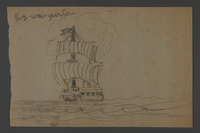
Drawing of a ship
Object
Artwork created by Charles Weingarten after the war. Charles Albert Weingarten is the son of Margarethe (Marguerite) Weingarten and Rudolph Gelb. He was born on Jan. 13, 1941, in Nice, France. In 1943 when the Germans invaded the area, Margarethe hid with Charles in the basement of a building in rue Verdi in Nice. In July 1943 Margarethe and Charles obtained false papers and moved to the grounds of a villa owned by the Matteudi family. They remained there through the end of World War II.
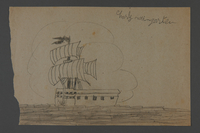
Drawing of a ship
Object
Artwork created by Charles Weingarten after the war. Charles Albert Weingarten is the son of Margarethe (Marguerite) Weingarten and Rudolph Gelb. He was born on Jan. 13, 1941, in Nice, France. In 1943 when the Germans invaded the area, Margarethe hid with Charles in the basement of a building in rue Verdi in Nice. In July 1943 Margarethe and Charles obtained false papers and moved to the grounds of a villa owned by the Matteudi family. They remained there through the end of World War II.

Drawing of a ship
Object
Artwork created by Charles Weingarten after the war. Charles Albert Weingarten is the son of Margarethe (Marguerite) Weingarten and Rudolph Gelb. He was born on Jan. 13, 1941, in Nice, France. In 1943 when the Germans invaded the area, Margarethe hid with Charles in the basement of a building in rue Verdi in Nice. In July 1943 Margarethe and Charles obtained false papers and moved to the grounds of a villa owned by the Matteudi family. They remained there through the end of World War II.

Drawing of a ship
Object
Artwork created by Charles Weingarten after the war. Charles Albert Weingarten is the son of Margarethe (Marguerite) Weingarten and Rudolph Gelb. He was born on Jan. 13, 1941, in Nice, France. In 1943 when the Germans invaded the area, Margarethe hid with Charles in the basement of a building in rue Verdi in Nice. In July 1943 Margarethe and Charles obtained false papers and moved to the grounds of a villa owned by the Matteudi family. They remained there through the end of World War II.
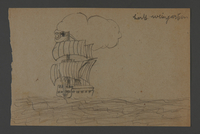
Drawing of a ship
Object
Artwork created by Charles Weingarten after the war. Charles Albert Weingarten is the son of Margarethe (Marguerite) Weingarten and Rudolph Gelb. He was born on Jan. 13, 1941, in Nice, France. In 1943 when the Germans invaded the area, Margarethe hid with Charles in the basement of a building in rue Verdi in Nice. In July 1943 Margarethe and Charles obtained false papers and moved to the grounds of a villa owned by the Matteudi family. They remained there through the end of World War II.
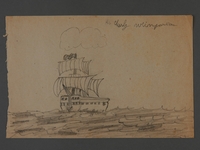
Drawing of a ship
Object
Artwork created by Charles Weingarten after the war. Charles Albert Weingarten is the son of Margarethe (Marguerite) Weingarten and Rudolph Gelb. He was born on Jan. 13, 1941, in Nice, France. In 1943 when the Germans invaded the area, Margarethe hid with Charles in the basement of a building in rue Verdi in Nice. In July 1943 Margarethe and Charles obtained false papers and moved to the grounds of a villa owned by the Matteudi family. They remained there through the end of World War II.
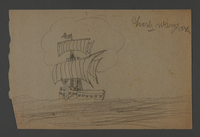
Drawing of a ship
Object
Artwork created by Charles Weingarten after the war. Charles Albert Weingarten is the son of Margarethe (Marguerite) Weingarten and Rudolph Gelb. He was born on Jan. 13, 1941, in Nice, France. In 1943 when the Germans invaded the area, Margarethe hid with Charles in the basement of a building in rue Verdi in Nice. In July 1943 Margarethe and Charles obtained false papers and moved to the grounds of a villa owned by the Matteudi family. They remained there through the end of World War II.
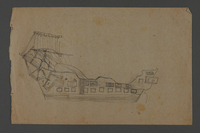
Drawing of a ship
Object
Artwork created by Charles Weingarten after the war. Charles Albert Weingarten is the son of Margarethe (Marguerite) Weingarten and Rudolph Gelb. He was born on Jan. 13, 1941, in Nice, France. In 1943 when the Germans invaded the area, Margarethe hid with Charles in the basement of a building in rue Verdi in Nice. In July 1943 Margarethe and Charles obtained false papers and moved to the grounds of a villa owned by the Matteudi family. They remained there through the end of World War II.
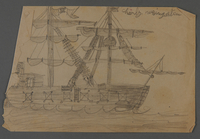
Drawing of a ship
Object
Artwork created by Charles Weingarten after the war. Charles Albert Weingarten is the son of Margarethe (Marguerite) Weingarten and Rudolph Gelb. He was born on Jan. 13, 1941, in Nice, France. In 1943 when the Germans invaded the area, Margarethe hid with Charles in the basement of a building in rue Verdi in Nice. In July 1943 Margarethe and Charles obtained false papers and moved to the grounds of a villa owned by the Matteudi family. They remained there through the end of World War II.

Drawing of a ship
Object
Artwork created by Charles Weingarten after the war. Charles Albert Weingarten is the son of Margarethe (Marguerite) Weingarten and Rudolph Gelb. He was born on Jan. 13, 1941, in Nice, France. In 1943 when the Germans invaded the area, Margarethe hid with Charles in the basement of a building in rue Verdi in Nice. In July 1943 Margarethe and Charles obtained false papers and moved to the grounds of a villa owned by the Matteudi family. They remained there through the end of World War II.
Drawing of a battle between American Indians and cowboys by a hidden child
Object
Child's drawing created by 4 year old Charly A. Weingarten circa 1944-45 while living in hiding with his mother. It depicts a fight between Amercan Indians and cowboys. Charles was born in 1941 in Italian occupied Nice not long after his mother Margarethe's release from Gurs internment camp. She was a Jewish refugee from Nazi Germany who had resided primarily in France since the early 1930s. In 1943, the Germans, who had occupied northern France since May 1940, assumed control of much of southern France. Margarethe went into hiding with Charly under assumed identities as Catholics. They lived in poverty on the grounds of an estate and Charly suffered from chronic bronchitis and severe malnutrition. Nice was liberated by American troops in August 1944. After the war ended in May 1945, Charly was sent to a children's home in Switzerland to recuperate.
Sketch of a large ocean liner drawn by a former hidden child
Object
Sketch of a large ocean liner drawn by Charles (Charly) Weingarten, 4, circa 1944. Charles was born in 1941 in Italian occupied Nice, France, six months after his mother Margarethe was released from Gurs internment camp. She had fled Nazi Germany for France in the early 1930s. When Germany invaded in May 1940, she was jailed as an enemy alien, then released after the German victory. They lived openly until September 1943, when the Germans occupied southern France after Italy surrendered to the Allies. Margarethe got them false papers as Catholics, and they wore cross pendants (see records 2002.420.23-24.) But they went into hiding because of the danger of deportation. They lived in poverty, in a cellar on the grounds of an estate. Charles was ill with bronchitis and severe malnutrition. Nice was liberated by American troops in August 1944. After the war ended in May 1945, Charles was sent to a children's home in Switzerland to recuperate.
Watercolor drawing of a girl holding a basket
Object
Artwork created by Charles Weingarten after the war. Charles Albert Weingarten is the son of Margarethe (Marguerite) Weingarten and Rudolph Gelb. He was born on Jan. 13, 1941, in Nice, France. In 1943 when the Germans invaded the area, Margarethe hid with Charles in the basement of a building in rue Verdi in Nice. In July 1943 Margarethe and Charles obtained false papers and moved to the grounds of a villa owned by the Matteudi family. They remained there through the end of World War II.
Colored pencil drawing
Object
Artwork created by Charles Weingarten after the war. Charles Albert Weingarten is the son of Margarethe (Marguerite) Weingarten and Rudolph Gelb. He was born on Jan. 13, 1941, in Nice, France. In 1943 when the Germans invaded the area, Margarethe hid with Charles in the basement of a building in rue Verdi in Nice. In July 1943 Margarethe and Charles obtained false papers and moved to the grounds of a villa owned by the Matteudi family. They remained there through the end of World War II.
Crayon drawing
Object
Artwork created by Charles Weingarten after the war. Charles Albert Weingarten is the son of Margarethe (Marguerite) Weingarten and Rudolph Gelb. He was born on Jan. 13, 1941, in Nice, France. In 1943 when the Germans invaded the area, Margarethe hid with Charles in the basement of a building in rue Verdi in Nice. In July 1943 Margarethe and Charles obtained false papers and moved to the grounds of a villa owned by the Matteudi family. They remained there through the end of World War II.
Ink drawing
Object
Artwork created by Charles Weingarten after the war. Charles Albert Weingarten is the son of Margarethe (Marguerite) Weingarten and Rudolph Gelb. He was born on Jan. 13, 1941, in Nice, France. In 1943 when the Germans invaded the area, Margarethe hid with Charles in the basement of a building in rue Verdi in Nice. In July 1943 Margarethe and Charles obtained false papers and moved to the grounds of a villa owned by the Matteudi family. They remained there through the end of World War II.
Ink sketches
Object
Artwork created by Charles Weingarten after the war. Charles Albert Weingarten is the son of Margarethe (Marguerite) Weingarten and Rudolph Gelb. He was born on Jan. 13, 1941, in Nice, France. In 1943 when the Germans invaded the area, Margarethe hid with Charles in the basement of a building in rue Verdi in Nice. In July 1943 Margarethe and Charles obtained false papers and moved to the grounds of a villa owned by the Matteudi family. They remained there through the end of World War II.
Ink sketches
Object
Artwork created by Charles Weingarten after the war. Charles Albert Weingarten is the son of Margarethe (Marguerite) Weingarten and Rudolph Gelb. He was born on Jan. 13, 1941, in Nice, France. In 1943 when the Germans invaded the area, Margarethe hid with Charles in the basement of a building in rue Verdi in Nice. In July 1943 Margarethe and Charles obtained false papers and moved to the grounds of a villa owned by the Matteudi family. They remained there through the end of World War II.
Theater: Sieber Jahre Freie Deutsche Buehne in Buenos Aires
Object
Book, published in 1946 and edited by P. Walter Jacob



